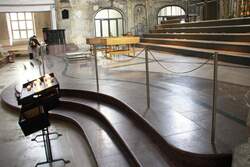Modern technology – concealed under 100 year-old marble slabs

The Church of the Holy Cross - world-famous for its choir and mentioned in historical documents as early as the 13th century - dominates the skyline of the German city of Dresden as one of its oldest structures. As part of restoration work, the church was planning to renovate the altar floor space to eliminate visible damage inflicted during World War II.
The substance of the floor covering, approximately 100 years old, still remained sound, but many of the large pavers (with dimensions up to 260 x 60 cm) were broken. Detached paver elements had been replaced with simple cement screed in numerous places. More than 60 years after the end of the war, the Lutheran church congregation was planning to restore the building to its original state - while at the same time adding a modern floor heating system as the primary heat source in the 177 m² butterfly-shaped altar area, which also serves as the stage for the church choir.
The space was not able to accommodate the necessary assembly height of approx. 90 mm for a conventional warm-water heating system. However, the renovation specialist Jörg Winkler, owner of "Winkler Fliesen & Naturstein" (Dippoldiswalde, Germany) recommended a perfect solution: the ceramic thermal comfort floor Schlüter-BEKOTEC-THERM.
Church leaders, who were committed to restoring the dignity of the altar with a conservative restoration that would apply the design concepts of the past to the present, were convinced by the numerous positive arguments.
Once the restoration project had been completed, it was quickly evident that the ceramic thermal comfort floor Schlüter-BEKOTEC-THERM had been the right choice: the majestic floor design had been restored to its old splendour - without expansion joints in the covering, and the members of the church choir and the Dresden Philharmonic Orchestra no longer have cold feet during winter concerts.